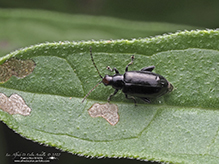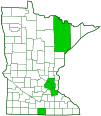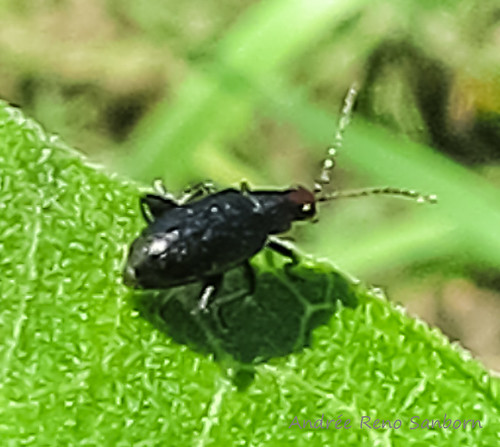red-headed flea beetle
(Systena frontalis)
Conservation • Description • Habitat • Ecology • Distribution • Taxonomy
Conservation Status |
|
|||||||
| IUCN Red List | not listed |
|||||||
| NatureServe | NNR - Unranked |
|||||||
| Minnesota | not listed |
|||||||
Description |
||
Red-headed flea beetle is a small, common, flea beetle. It occurs in the United States and southern Canada east of the Great Plains. Adults are generalist feeders and can be found on a wide variety of plants, including common dandelion, dogbane, foxtail, giant ragweed, Joe-Pye weed, lambsquarters, pigweed, red clover, smartweed, thistle, touch-me-not, and velvetleaf. The larvae live in the soil and feed on roots and underground stems (rhizomes). Red-headed flea beetle is a serious pest of woody and herbaceous ornamental plants in nurseries. It creates unsightly perforations in leaves, which make the plants unsellable. Adults are ⅛″ to ¼″ (3.0 to 6.5 mm) in length. The body is shiny, moderately elongated, parallel-sided, and somewhat depressed, flat when viewed from the side. The head is red or reddish-yellow and is clearly visible from above. The antennae are slender, thread-like, half as long as the body, and slightly widened at the tip. They have 11 segments. Segments 3, 4, and 5 are dull yellow, the remaining segments are more or less brownish-black. Segment 2 is shorter than segment 3 and longer than segment 4. Segment 5 is longer than segments 4 and 6. The mouthparts are directed downwards. The eyes are not notched. The exoskeletal plate covering the thorax (pronotum) is black, wider than the head, rectangular, about one-third wider than long, and weakly curved on the sides. The front corners are cut off (truncate) at an oblique angle. The rear corners are acutely angled. The surface is minutely wrinkled and moderately pitted (punctate). The sides are narrowly flattened (margined). The hardened wing covers (elytra) are wider at the base than the pronotum. They are entirely black, moderately punctate, and very narrowly margined on the sides. They do not have a distinct downward slope at the rear (apical declivity). The legs are black and relatively short. On the hind leg the third segment (femur) is enlarged for jumping. The last part of each leg (tarsus), corresponding to the foot, has five segments. The fourth segment is very short and is concealed within the broadened tip of the third segment, making the tarsus appear to have only four segments. There is a pair of equally sized claws at the tip of the tarsus. |
||
Size |
||
⅛″ to ¼″ (3.0 to 6.5 mm) |
||
Similar Species |
||
Habitat |
||
|
||
Ecology |
||
Season |
||
One generation per year in the wild: July to September Up to four generations per year in nurseries: May to October |
||
Behavior |
||
Like all flea beetles, adults jump when disturbed. |
||
Life Cycle |
||
Single, pale yellow eggs are deposited in the soil, where they overwinter. They require a chilling period of at least fifteen weeks before hatching, though a small percentage will hatch without the chilling period. |
||
Larva Food |
||
Plant roots and rhizomes |
||
Adult Food |
||
Leaves of a wide variety of plants, including common dandelion, dogbane, foxtail, giant ragweed, Joe-Pye weed, lambsquarters, pigweed, red clover, smartweed, thistle, touch-me-not, and velvetleaf. |
||
Distribution |
||||
|
Sources |
|||
| 6/29/2023 | ||||
Occurrence |
||||
|
||||
Taxonomy |
|||
Order |
Coleoptera (Beetles) | ||
Suborder |
Polyphaga (Water, Rove, Scarab, Long-horned, Leaf, and Snout Beetles) | ||
Infraorder |
Cucujiformia | ||
Superfamily |
Chrysomeloidea (leaf beetles and allies) | ||
Family |
Chrysomelidae (leaf beetles) | ||
Subfamily |
Galerucinae (skeletonizing leaf and flea beetles) | ||
Tribe |
Alticini (flea beetles) | ||
Genus |
Systena | ||
Synonyms |
|||
|
|||
Common Names |
|||
red-headed flea beetle |
|||
Glossary
Elytra
The hardened or leathery forewings of beetles used to protect the fragile hindwings, which are used for flying. Singular: elytron.
Femur
On insects and arachnids, the third, largest, most robust segment of the leg, coming immediately before the tibia. On humans, the thigh bone.
Pronotum
The exoskeletal plate on the upper side of the first segment of the thorax of an insect.
Rhizome
A horizontal, usually underground stem. It serves as a reproductive structure, producing roots below and shoots above at the nodes.
Punctate
Dotted with pits (punctures), translucent sunken glands, or colored spots of pigment.
Tarsus
On insects, the last two to five subdivisions of the leg, attached to the tibia; the foot. On spiders, the last segment of the leg. Plural: tarsi.
Visitor Photos |
|||||
Share your photo of this insect. |
|||||
| This button not working for you? Simply email us at info@MinnesotaSeasons.com. Attach one or more photos and, if you like, a caption. |
|||||
Alfredo Colon |
|||||
 |
|||||
MinnesotaSeasons.com Photos |
|||||
|
|||||

Visitor Videos |
|||
Share your video of this insect. |
|||
| This button not working for you? Simply email us at info@MinnesotaSeasons.com. Attach a video, a YouTube link, or a cloud storage link. |
|||
Other Videos |
|||
| Red-Headed Flea Beetle Larval Scouting NC State Extension |
|||
About
Feb 8, 2017 For more information on topics like this, please visit NC Cooperative Extension on the web at http://www.ces.ncsu.edu |
|||

Created: 6/29/2023
Last Updated:




